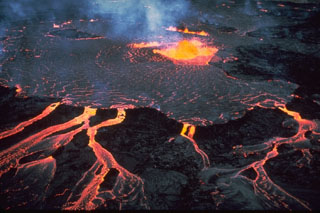Report on Kilauea (United States) — 2 April-8 April 2025
Smithsonian Institution / US Geological Survey
Weekly Volcanic Activity Report, 2 April-8 April 2025
Managing Editor: Sally Sennert.
Please cite this report as:
Global Volcanism Program, 2025. Report on Kilauea (United States) (Sennert, S, ed.). Weekly Volcanic Activity Report, 2 April-8 April 2025. Smithsonian Institution and US Geological Survey.
Kilauea
United States
19.421°N, 155.287°W; summit elev. 1222 m
All times are local (unless otherwise noted)
The Hawaiian Volcano Observatory (HVO) reported that the eruption within Kilauea’s Kaluapele summit caldera, from vents along the SW margin of Halema’uma’u Crater, continued at variable levels during 1-8 April. Weak spattering at the N vent that had begun on 31 March changed to low lava fountaining and lava pond activity that ceased at 2122 on 1 April. Lava fountaining began at the S vent around 0800 on 1 April and rapidly increased in height, with fountains rising to 245 m. Volcanic gas emissions were elevated; during the period of high fountaining, sulfur dioxide emission rates were 50,000 tonnes per day along Highway 11, just NW of Halema’uma’u Crater. Small pumice, ash, and Pele’s hair fell on Highway 11, leaving deposits about 1 cm thick, and in closed areas of Hawai’i Volcanoes National Park. The fountain heights dropped significantly to 90 m by 0950 on 2 April and then ceased at 1203. Small spattering at the S vent was observed later in the afternoon. Lava covered about 50 percent of the crater floor.
Incandescence at the S vent was visible during 3-5 April and at the N vent during 4-7 April. During 3-7 April a dense white gas plume rose from the vents and bright sulfur deposits were visible on the vent cones. Lava flows were periodically active on the E crater floor. Incandescence at the S vent intensified at around 2120 on 7 April, indicating rising lava in the cone. Lava overflowed the vent at 2215 and spread across the crater floor. Low spatter fountains rising 5-30 m were visible at 0250 on 8 April. Spattering and activity at a lava pond in the N vent was visible at around 0400. The Volcano Alert Level remained at Watch (the third level on a four-level scale) and the Aviation Color Code remained at Orange (the third color on a four-color scale).
Geological Summary. Kilauea overlaps the E flank of the massive Mauna Loa shield volcano in the island of Hawaii. Eruptions are prominent in Polynesian legends; written documentation since 1820 records frequent summit and flank lava flow eruptions interspersed with periods of long-term lava lake activity at Halemaumau crater in the summit caldera until 1924. The 3 x 5 km caldera was formed in several stages about 1,500 years ago and during the 18th century; eruptions have also originated from the lengthy East and Southwest rift zones, which extend to the ocean in both directions. About 90% of the surface of the basaltic shield volcano is formed of lava flows less than about 1,100 years old; 70% of the surface is younger than 600 years. The long-term eruption from the East rift zone between 1983 and 2018 produced lava flows covering more than 100 km2, destroyed hundreds of houses, and added new coastline.
Source: US Geological Survey Hawaiian Volcano Observatory (HVO)

